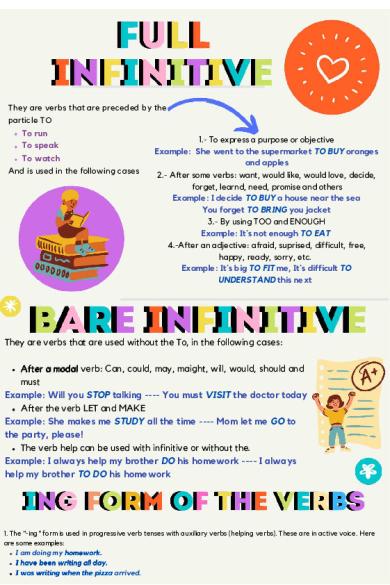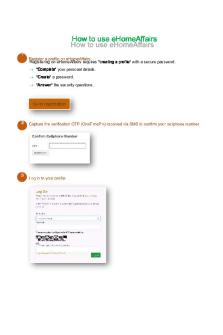Infografía sobre How to use full infinitive, bare infinitive and -ing form of the verbs. PDF

| Title | Infografía sobre How to use full infinitive, bare infinitive and -ing form of the verbs. |
|---|---|
| Course | Pedagogía |
| Institution | Universidad Veracruzana |
| Pages | 1 |
| File Size | 186.1 KB |
| File Type | |
| Total Downloads | 98 |
| Total Views | 127 |
Summary
Infografía que habla sobre los temas de How to use full infinitive, bare infinitive and -ing form of the verbs.
Colocando por lo menos 3 ejemplos de cada uno de los temas seleccionados...
Description
They are verbs that are preceded by the particle TO To run To speak To watch And is used in the following cases
1.- To express a purpose or objective Example: She went to the supermarket TO BUY oranges and apples 2.- After some verbs: want, would like, would love, decide, forget, learnd, need, promise and others Example: I decide TO BUY a house near the sea You forget TO BRING you jacket 3.- By using TOO and ENOUGH Example: It´s not enough TO EAT 4.-After an adjective: afraid, suprised, difficult, free, happy, ready, sorry, etc. Example: It´s big TO FIT me, It´s difficult TO UNDERSTAND this next
They are verbs that are used without the To, in the following cases: After a modal verb: Can, could, may, maight, will, would, should and must Example: Will you STOP talking ---- You must VISIT the doctor today After the verb LET and MAKE Example: She makes me STUDY all the time ---- Mom let me GO to the party, please! The verb help can be used with infinitive or without the. Example: I always help my brother DO his homework ---- I always help my brother TO DO his homework
1. The "-ing" form is used in progressive verb tenses with auxiliary verbs (helping verbs). These are in active voice. Here are some examples: I am doing my homework. I have been writing all day. I was writing when the pizza arrived....
Similar Free PDFs

Unit 7. To Infinitive and ing
- 4 Pages

Gerunds and infinitive
- 4 Pages

Infinitive-exercise-1
- 1 Pages

How to use SPSS
- 4 Pages

How to use genkouyoushi
- 1 Pages

How To use eHomeAffairs
- 6 Pages

How to Use Excel
- 27 Pages
Popular Institutions
- Tinajero National High School - Annex
- Politeknik Caltex Riau
- Yokohama City University
- SGT University
- University of Al-Qadisiyah
- Divine Word College of Vigan
- Techniek College Rotterdam
- Universidade de Santiago
- Universiti Teknologi MARA Cawangan Johor Kampus Pasir Gudang
- Poltekkes Kemenkes Yogyakarta
- Baguio City National High School
- Colegio san marcos
- preparatoria uno
- Centro de Bachillerato Tecnológico Industrial y de Servicios No. 107
- Dalian Maritime University
- Quang Trung Secondary School
- Colegio Tecnológico en Informática
- Corporación Regional de Educación Superior
- Grupo CEDVA
- Dar Al Uloom University
- Centro de Estudios Preuniversitarios de la Universidad Nacional de Ingeniería
- 上智大学
- Aakash International School, Nuna Majara
- San Felipe Neri Catholic School
- Kang Chiao International School - New Taipei City
- Misamis Occidental National High School
- Institución Educativa Escuela Normal Juan Ladrilleros
- Kolehiyo ng Pantukan
- Batanes State College
- Instituto Continental
- Sekolah Menengah Kejuruan Kesehatan Kaltara (Tarakan)
- Colegio de La Inmaculada Concepcion - Cebu








